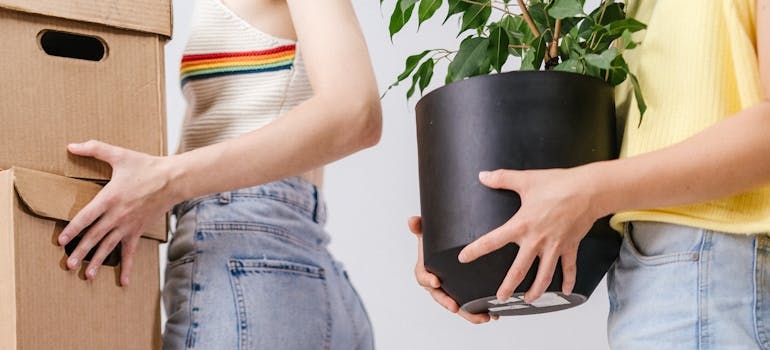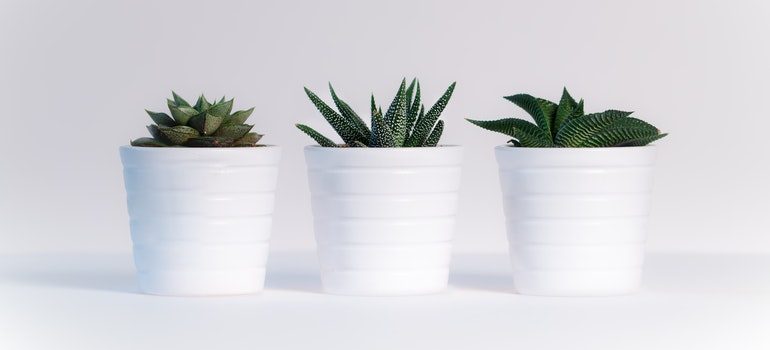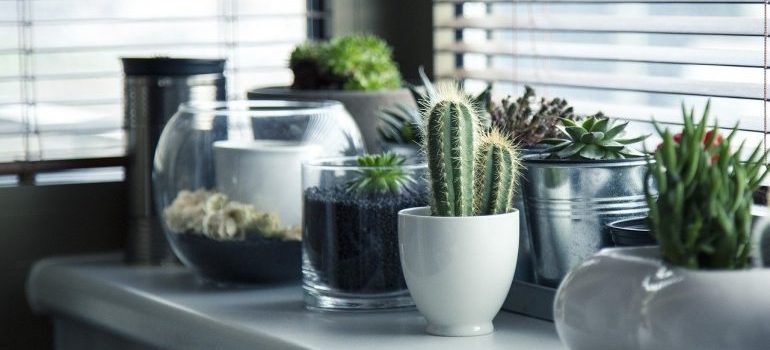How to Prepare Plants for Relocation
Relocating plants can be a delicate process, especially when considering the unique climate conditions of Boise, ID. Proper preparation, care, and monitoring are essential to ensure that your beloved greenery thrives in its new environment. This Peasley Moving & Storage guide aims to provide a comprehensive step-by-step approach to help you prepare plants for relocation, taking into account Boise’s specific climate factors. So, get ready to show off your green thumb and give your plants the best move ever!
Boise’s Climate and Its Impact on Plants
Boise, ID, is characterized by a semi-arid climate, with hot, dry summers and cold winters. Average summer temperatures can soar above 90°F, while winter temperatures can dip below freezing. Precipitation is relatively low, averaging about 12 inches annually, with most of it occurring in the winter months. The limited rainfall and temperature extremes mean that plants must be resilient and well-adapted to survive these conditions.
This climate can significantly impact plant health, especially during relocation. Plants accustomed to Boise’s unique temperature fluctuations and moisture levels will need careful handling to avoid transplant shock. Understanding these climate conditions is crucial for timing the move with moving services Boise ID and preparing the plants appropriately. For instance, relocating plants during the milder spring or fall months can help minimize stress.
Additionally, Boise’s soil quality plays a vital role in plant health. The region’s soil is generally well-drained and can be sandy or loamy, which affects water retention and root development. Plants adapted to Boise’s soil conditions typically require good drainage to prevent root rot. When relocating plants, it’s essential to consider the soil quality at the new site and amend it if necessary. Adding organic matter like compost can improve soil structure, increase nutrient availability, and enhance water retention, providing a better environment for the plants to establish themselves.

Pre-Relocation Preparation
Proper preparation is crucial for a successful plant relocation, especially in Boise’s unique climate. Here’s a detailed guide to help you get started.
Assessing Which Plants Are Suitable for Relocation
Before you begin, evaluate which plants are best suited for relocation. Hardy plants, such as perennials, shrubs, and small trees, generally handle the stress of moving better than delicate annuals or large, mature trees. Hardy plants can often recover from minor root damage and environmental changes, making them ideal candidates for relocation. On the other hand, sensitive plants, including those with extensive root systems or those that are particularly sensitive to temperature changes, may not survive the move.
Identifying Hardy vs. Sensitive Plants
Hardy plants typically include native species, drought-tolerant varieties, and those with well-established root systems. Examples in Boise might be sagebrush, yarrow, and coneflower. Sensitive plants often include exotic species, plants with shallow or fragile root systems, and those that require specific microclimates to thrive.
Checking the Health of Plants Before Moving
Inspect your plants for any signs of disease or pest infestation. Healthy plants are more likely to survive the stress of relocation. Look for strong stems, vibrant leaves, and well-established roots. Avoid moving plants that are already struggling, as the additional stress may lead to further decline.
Timing the Relocation
The timing of your plant relocation is critical. The best time to move plants in Boise is during the cooler months, either in early spring before new growth begins or in the fall after the plants have entered dormancy. This timing helps minimize stress and allows the plants to establish roots before the extreme temperatures of summer or winter.
- Spring is ideal for most perennials and shrubs. Moving plants during this time allows them to take advantage of the growing season.
- Fall is suitable for hardy plants and many trees. Fall relocation allows roots to establish while the plant is dormant, reducing water needs and transplant shock.
Why not the other two seasons? Summer is generally not recommended due to the intense heat and dry conditions, which can cause severe transplant shock and dehydration. On the other hand, moving plants during winter can be challenging due to frozen ground and low temperatures, which can damage roots and hinder proper establishment.

Gathering Necessary Supplies
A smooth and successful plant relocation requires careful preparation and the right tools. Before starting the process, ensure you have gathered all the necessary supplies to minimize stress on your plants and make the relocation as efficient as possible. Proper planning and having the correct materials on hand will help safeguard your plants’ health and improve their chances of thriving in their new environment. Essential items include:
- Tools: Shovels, spades, garden forks, and pruning shears. These tools help in digging up plants and pruning them before the move.
- Containers: While Boise moving boxes are great for your other belongings, your plants will need adequate pots or containers of appropriate sizes. Ensure they have adequate drainage holes.
- Soil: Quality potting mix or soil amendments. Depending on your plant’s needs, you might need soil specifically formulated for certain types of plants.
- Packing Materials: Burlap, plastic wrap, or newspapers. These materials help protect roots during the move.
Having the right supplies on hand is crucial to minimize stress on your plants during the relocation process. Each tool and material serves a specific purpose to ensure that plants are safely and efficiently moved from their original location to their new home.
Preparation of Pots, Soil, and Packing Materials
Once you have gathered all the necessary supplies, the next step is to prepare them for use. Proper preparation of pots, soil, and packing materials is essential to ensure that your plants are relocated with minimal disruption and stress:
- Pots: Select pots that are slightly larger than the plant’s root ball. If reusing pots, clean them thoroughly to prevent disease transmission. Ensure the pots have drainage holes to prevent waterlogging.
- Soil: Use fresh, high-quality potting soil or garden soil mixed with compost. This ensures that the plants have access to necessary nutrients and promotes healthy root growth. For plants with specific soil requirements, consider using a specialized mix, such as cactus soil or orchid bark.
- Packing Materials: For larger plants, damp burlap wraps root balls, helping retain moisture and protect roots. Plastic pots or containers with soil work well for smaller plants. Newspaper can be used to cushion delicate plants during transport.
If you thoroughly prepare these materials, you will create an optimal environment for your plants during the relocation process. Proper preparation helps ensure that your plants remain healthy and resilient, increasing their chances of successful establishment in their new location.

Steps for Safely Uprooting Plants
To prepare plants for relocation successfully, you need to uproot them safely. It requires careful planning and technique to minimize stress and ensure their survival. Proper execution of these steps will help maintain their health during the transition.
Watering Plants Before Uprooting
Watering your plants thoroughly a day or two before uprooting is crucial. Well-hydrated plants are more resilient and easier to dig up without causing excessive root damage. This pre-emptive watering ensures that the soil around the roots is moist, making it easier to lift the plant with its root system intact. It also helps reduce transplant shock by providing the plants with the necessary moisture during the transition.
Techniques for Digging Up Different Types of Plants
Different plants require specific techniques for safe uprooting:
- Perennials: Begin by digging around the plant’s base, approximately 6-12 inches from the stem. Gently loosen the soil and lift the plant, ensuring that the root ball is intact. Perennials generally have smaller root systems, making them easier to handle.
- Shrubs: For larger shrubs, dig a trench around the plant’s drip line (the outer edge of the foliage). This trench should be about 12-18 inches deep. Gradually work your way inward, carefully loosening the roots with a spade or garden fork. Lift the shrub with as much of the root system as possible.
- Trees: Uprooting trees, especially mature ones, is more challenging. Dig a wide trench around the drip line, reaching a depth of at least 18-24 inches. Cut through any large roots with a sharp spade or saw, and carefully undercut the tree to free the root ball. Use burlap to wrap the root ball securely for transportation.
With these tips, you can uproot your plants safely and prepare them for a successful relocation. However, keep in mind that the following steps: proper watering, digging techniques, root preservation, and pruning are all essential to ensuring that your plants remain healthy and ready to thrive in their new environment.
Handling and Preserving Root Systems
Preserving the root system is critical for plant survival. After digging up the plant, handle the root ball gently to avoid breaking or damaging the roots. For large plants, wrap the root ball in damp burlap to keep it moist and protected. For smaller plants, placing them in pots with appropriate soil can help maintain root health. Keeping the roots moist and cool during the relocation process is essential to prevent desiccation and damage.
Proper Pruning Techniques to Minimize Stress
Pruning before relocation helps reduce the plant’s water and nutrient needs, making it easier for the plant to establish itself in its new location. Remove any dead or damaged branches to direct the plant’s energy towards recovery. For shrubs and trees, trim back about one-third of the top growth to balance the loss of roots. This practice not only reduces transplant shock but also encourages new growth once the plant is re-established.
Prepare Plants for Relocation and Transport
Preparing plants for transport involves different strategies depending on the distance of the move. For short-distance moves, such as relocating within Boise, secure the plants in sturdy containers. Pots or temporary plastic containers work well, and cushioning with newspaper or bubble wrap can prevent damage.
For long-distance moves, additional precautions are necessary. While long-distance movers in Idaho transport your home, you need to use insulated boxes or crates to protect plants from temperature fluctuations. That way, you ensure they are well-secured to avoid tipping or jostling during transport.
Using Appropriate Containers and Securing Plants
Choosing the right containers is crucial. Individual pots are ideal for smaller plants, while larger plants may need burlap-wrapped root balls placed in crates. Secure plants by packing them tightly to prevent movement. For taller plants, gently tying the foliage can help protect them from damage.
Maintaining Moisture and Temperature During Transport
Maintaining moisture and temperature during transport is vital to prevent stress. Keep roots moist by wrapping them in damp burlap or placing them in containers with moist soil. Transport plants during the cooler parts of the day, and if possible, use a climate-controlled vehicle to avoid extreme temperatures.
Tips for Transporting Plants in Different Weather Conditions
Weather conditions play a significant role in plant transport. In hot weather, avoid moving plants during peak heat; instead, cover them with shade cloth or place them in a shaded area. In cold weather, insulate plants with blankets or towels and avoid leaving them in unheated vehicles for extended periods. By taking these precautions, you can ensure your plants arrive at their new location healthy and ready for replanting.

Replanting at the New Location
Successfully replanting your plants at the new location after moving to Idaho begins with preparing the planting site. You did prepare plants for relocation well. Now, you need to start setting up your new home by clearing the area of weeds and debris. Amend the soil with organic matter, such as compost, to improve fertility and drainage. Testing the soil pH and adjusting it if necessary can also benefit plant health.
Understanding the Microclimate of the New Location
Understanding the microclimate of the new location is crucial. Observe sunlight patterns, wind exposure, and moisture levels to choose the best spots for your plants. Mimicking their previous conditions as closely as possible will help reduce transplant shock.
Correct Planting Techniques
When planting, use the correct techniques to ensure the health of your plants. Dig a hole slightly larger than the root ball and place the plant at the same depth it was previously growing. Ensure proper spacing to allow for growth and airflow. Backfill the hole with soil, gently firming it around the roots to eliminate air pockets.
Initial Care After Replanting
Initial care after replanting is essential for plant recovery. Water the plants thoroughly immediately after planting to help settle the soil and hydrate the roots. Mulch around the base of the plants to retain moisture, regulate soil temperature, and suppress weeds. Protect your plants from pests by monitoring them regularly and taking action at the first sign of trouble.
Post-Relocation Plant Care
Caring for your plants after you transport other belongings with local movers in Boise and monitoring their health in the first few weeks is vital. Keep a close eye on your plants for any signs of stress or disease. Look for indicators that can suggest that the plant is struggling to adapt. Transplant shock is a common issue after relocation. Symptoms include drooping leaves, stunted growth, and leaf drop. To address transplant shock, ensure the plant is adequately watered and consider using a root stimulant to encourage new growth. Protecting the plant from extreme temperatures and providing partial shade can also help reduce stress.
You’re setting a great base for a safe move when you prepare plants for relocation properly. For long-term care, continue to monitor your plants and provide regular maintenance. Mulching around the base can help retain soil moisture and regulate temperature. Prune any dead or damaged branches to promote healthy growth. Regularly check for pests and diseases and treat them promptly. With consistent care and attention, you can help your plants transition smoothly and flourish in their new environment, ensuring they continue to bring beauty and life to your surroundings in Boise!

